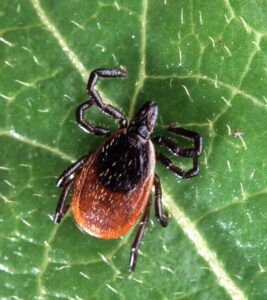 “We love our outdoor spaces – gardening, walking our pets, hiking. People in the Hudson Valley spend a lot of time outside,” says State Sen. Pete Harckham. He’s right, of course, but increasingly, when enjoying the fresh air and our beautiful environment, we happy River Town-ies are risking contracting Lyme or one of the other tick-born diseases (TBDs) which are now more prevalent than ever. In 2018 the Centers for Disease Control estimated that between 2004 and 2016, illness from ticks and insects tripled, with ticks making up 75% of those numbers. Climate change and its effect on wildlife are part of the explanation.
“We love our outdoor spaces – gardening, walking our pets, hiking. People in the Hudson Valley spend a lot of time outside,” says State Sen. Pete Harckham. He’s right, of course, but increasingly, when enjoying the fresh air and our beautiful environment, we happy River Town-ies are risking contracting Lyme or one of the other tick-born diseases (TBDs) which are now more prevalent than ever. In 2018 the Centers for Disease Control estimated that between 2004 and 2016, illness from ticks and insects tripled, with ticks making up 75% of those numbers. Climate change and its effect on wildlife are part of the explanation.
New York State is second only to Pennsylvania for the incidence of Lyme disease, and Harckham has recently co-sponsored a bipartisan bill to bolster funding to combat these diseases. “It’s a prevalent and underserved issue in our area,” he says, and his legislation creates a tax checkoff for Lyme and TBD education, research and prevention efforts, which would allow taxpayers to voluntarily contribute to a fund dedicated to bolstering work in this field.
Better factual knowledge will certainly help the medical establishment prepare for and treat this growing problem. But in the meantime, and no longer just during the summer, we are faced with a serious health issue that’s widespread and hard to detect unless we are watchful. I speak with feeling, having recently found three ticks under my skin and been diagnosed with Rocky Mountain spotted fever and babesiosis, two of the 16 different illnesses arising from tick infection. Both these particular diseases were rarely seen on the Eastern Seaboard in earlier years. Now, they are relatively common.

Swift treatment is important if you are unlucky enough to discover an embedded tick – although finding one is better than not even knowing you’ve been infected, which is common. Walk-in medical treatment centers are good places to receive speedy attention, like Immediate Medical Care MD in the Arcadian Shopping Center in Ossining, operated by Dr. Anupama Pani.
“Lyme and TBDs are much more common, these days, all year round,” says Pani. “Our radar has to be up.” She is now testing for these diseases routinely, and considers a wide range of symptoms possible indicators, anything from headaches and fevers to swollen joints and heart arrhythmias. Lyme can be an acute infection or a long-term condition. Two recent patients suffered Bell’s palsy as a result of Lyme. “The more we check, the more we find,” the doctor says.

And this is not just a human dilemma. As Dr. Patricia Doherty, vet at Sleepy Hollow Animal Hospital, points out, “Dogs get Lyme and TBDs too, especially little dogs. With the bigger dogs, owners tend to be more aware about the need to vaccinate. But with the little ones, owners will say, ‘But we’re just walking in my neighborhood…’”
Fortunately, good prevention options for dogs (of all sizes) exist, not just vaccinations but collars, topical ointments and oral flea/tick preventatives too. If Lyme or a TBD is diagnosed, the remedy is the same as for humans – a long course of the antibiotic doxycycline.
Doherty was amazed by the frequency of Lyme and TBD diagnoses when she first started work at the three-vet practice three years ago. Now these preventative treatments have the problem under control for existing patients. But new clients are arriving with tick problems. And she’s also aware of a new tick in the area, the Asian longhorned tick, which is tiny and appears resistant to current preventatives. It doesn’t yet carry disease, but could in the future.
“What we need is an information campaign, letting people know what to look for and when to go to the doctor,” Doherty says, which is where she is in step with both Pani and Harckham. All three are united in the need to avoid long grass, to use tick repellents on our clothes and our skin, to spray our yards, and indoors to check our clothes, our bodies and our animals.
Like the police officer said, “Let’s be careful out there.”
health.ny.gov/environmental/pests/dress_to_repel.pdf
sleepyhollowanimalhospital.com
immediatemedicalcaremd.com






